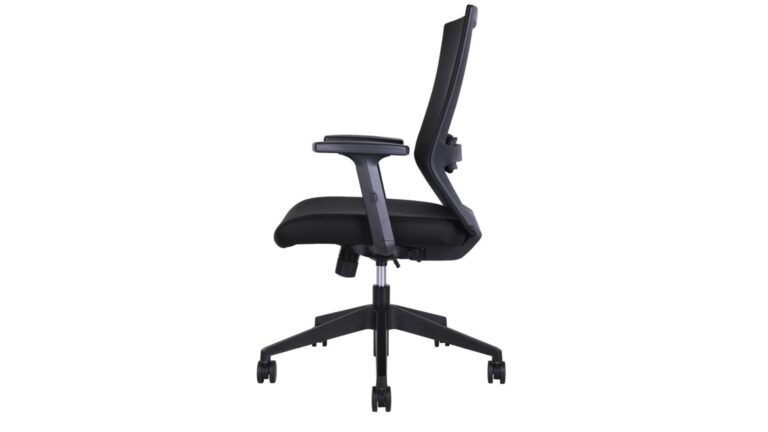According to research conducted by SafeWork Australia, the average workers spends around 76% of their working day sitting, and around a quarter of Australian workers sit for more than eight hours a day. Staying sedentary for long periods can negatively affect your health, with long periods of sitting increasing the risk of cardiovascular disease, type II diabetes and even some cancers.
Even if you stay active and get up and move often, having the wrong office chair when you are sitting can still have negative impacts on your health in the form of ergonomic injuries and musculoskeletal problems. Finding the right office chair for your setup and situation is vital for avoiding problems developing.
So how do you go about choosing the right office chair for your office or your work from home setup? There are many criteria that need to be investigated before you make any decisions, from what materials the chair is made from, to whether it fits within the company’s, or your own, budget.
Office Chair Materials
The materials from which a chair is made can determine its durability, weight, ease of cleaning, the breathability of the fabrics and even whether a person may have an allergic reaction to materials.
When choosing materials for a chair, you should consider the environment, the airflow in the office, the purpose of the chair (such as if it’s for a meeting room or if it’s for prolonged, everyday use) and how long it will be used a day.
The most common materials used in office chairs are leather, fabric and mesh, each having their own advantages and disadvantages. Leather looks great and is typically easy to clean, but doesn’t breathe as well as the other materials, potentially making leather a hot and sticky material in hot environments or offices without great ventilation.
Fabric is a breathable, durable and affordable material for office chairs. Fabric can be a good choice for warmer environments or offices as it breathes easily so it won’t get hot and sticky as readily as leather. Unfortunately, fabric isn’t as easy to clean as leather and can stain or discolour fairly easily.
Both leather and fabric chairs offer good support for the back and neck, as the materials are used as a covering for the chairs rather than the body of the chair itself. Mesh chairs, on the other hand, use tightly strung mesh for the back/neck rest and in some cases the actual seat as well.
While mesh is excellent for allowing air to freely circulate around the body keeping you cool, a mesh chair may not be able to provide the same level of support as fabric or leather.
Seat height, depth and Width
The optimal sitting position in an office chair is with hips and knees at 90-degree angles and feet flat on the floor. If a chair is too high or too low for the user, this optimal sitting position may not be possible, increasing the risk of discomfort or ergonomic injuries. Before buying any chair, you must check to see if it can be set to a best height for a user. While most chairs should be effective for average heights, people that fall outside of the average may have to look harder to find the right chair for them.
Similarly, the depth of the seat – the distance between the front of the seat and the back rest – can affect the comfort and effectiveness of an office chair. The depth of a seat should support the legs and allow those sitting to take full advantage of back support. If the seat is too shallow, the les won’t be supported. If the seat is too deep, then the legs may be supported but the back is too far away from any support for a proper sitting position.
Office chairs, especially those that have arms, also need to have a seat wide enough to support a user. A seat that is too wide may encourage users to slouch while using the armrests, while a seat that is too narrow may be uncomfortable or unusable for a portion of users.
Before buying any chair, ensuring that it has a seat appropriate for the user, with good adjustable height and a width and depth that can properly support a good sitting posture.
Weight allowance
Weight capacity or allowance is a measurement of the maximum weight that an office chair can support without being structurally compromised. One of the most common examples of weight limits being surpasses is the pneumatic lift in an office chair sinking randomly or no longer working at all.
Office chairs with higher weight capacities are also typically built to offer better cushioning for the seat and back support to help ensure good posture and comfortable seating for heavier users.
Armrests
There are a number of potential pros and cons to armrests that should be considered before deciding whether you want or need them. If you regularly type or use a mouse, arm rests can help support the arms in a natural position, reducing fatigue and the risk of ergonomic injury.
For some users, armrests may limit their mobility, making it difficult to move freely or reach items on a desk. If armrests aren’t adjustable or not suited to body proportions, the armrests may not align with a person’s natural arm position leading to discomfort or awkward posture. Armrests may also pose a problem with desks as they may not fit under them, forcing you to sit farther away than they may like and negatively affecting posture as a result.
Lumbar Support
Good lumbar support is one of the most important parts of any office chair, as it’s a crucial element that can significantly impact comfort and well-being during long workdays. SafeWork Australia ergonomic guidelines emphasise the importance of adjustable lumbar support in office chairs.
An effective lumbar support system should supply a supportive contour that fits snugly into the natural curve of your lower back. Ergonomics Australia recommends choosing office chairs that have a lumbar curve that matches the S-curve of your spine. This contour ensures that your lumbar region receives proper support, reducing the risk of slouching or hunching forward. Additionally, the lumbar support should strike a balance between firmness and comfort.
The Victorian Government’s Better Health Channel suggests that lumbar support should be firm enough to provide adequate support without causing pressure points. Ensuring the right balance between firmness and comfort can prevent discomfort and fatigue during extended periods of sitting.
An office chair’s lumbar support should be height and depth customisable to suit different body types and preferences. This kind of customisation allows people to fine-tune the shape and position of lumbar support to match the natural curvature of the lower back. WorkSafe Victoria highlights the significance of adjustable lumbar support in minimising the risk of musculoskeletal issues and discomfort.
Price and Warranty
Office chairs can range in price from under $100 to many thousands of dollars, so depending on your budget, the range of chairs available may vary greatly. There is no hard and fast rule for how much you should spend on a chair, but shopping around and price matching can help you get the right chair for your budget.
Limiting the features of a chair can help reduce costs. If you do not need armrests, or have a standalone lumbar support device, you can concentrate on looking for bar bones chairs. Opting for cheaper materials, like fabric or mesh can also cut costs.
As important as price is the warranty that comes with the chair – after all, chairs cost a fair amount of money and you don’t want to have to buy another any time soon. If possible, look for a warranty that covers service and repairs for at least two years. Check to see if the warranty covers manufacturing defects (nobody wants a wobbly chair) and if they offer repairs or replacements if something breaks or goes wrong. Some warranties even cover things like normal wear and tear, but this is usually restricted to very expensive chairs with warranties of a decade or longer.
Looks
Nobody wants an ugly chair, but when it comes to buying an office chair, for an office of work from home setup, looks should be the last factor you consider when looking for the perfect chair. While the style or materials of a chair may be a factor in any buying decision, buying a chair that provides ample support, is comfortable, is priced well, has a good warranty and the features you need is ultimately far more important than buying a chair that looks good but doesn’t meet all the other criteria.

